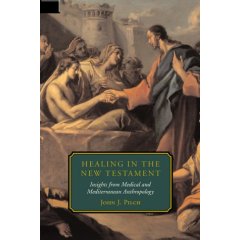I observe that more congregations are offering “healing services†as part of their ministries. We offered such at my former congregation and every now and then people ask me about it. On those opportunities I stress that it wasn’t a “healing service,†but rather, a “Service of Prayer for Healing and Wholeness.†The emphasis was on the prayers of the Church, not on any notion about our ability to miraculously “heal†people of broken bones or spirits.

John Pilch’s book Healing in the New Testament: Insights from Medical and Mediterranean Anthropology (Minneapolis: Fortress Press, 2000. 180 pp. $18.00. ISBN 0-8006-3178-1) can be a rich theological resource for any congregation who wants to offer a “healing ministry.†Pilch draws upon models and concepts from Mediterranean and medical anthropology to help the modern biblical exegete more respectfully interpret the biblical New Testament accounts of healing. He presents a model developed by Kluckhohn and Strodbeck for comparing values, such as health and sickness, cross-culturally as the basis for his approach to the interpretation of healing in the New Testament. This model, he contends, provides a more appropriate tool to interpreting first-century Mediterranean understanding of health and healing, sickness and illness, and the healthcare systems and practitioners of the time. The contrast provided between common 21st century understandings of clinical sickness to first-century cultural dyadic illness is enlightening.
The author presents an anthropological model of healthcare systems in which the system and society or culture shapes the meaning and interpretation that persons give to their experiences. Pilch then applies the definitions and models to the narratives found in the four Gospels relating to sick people, their symptoms, healers, and remedies.
In the introductory chapter on medical anthropology, Pilch argues that in traditional cultures a dichotomy between medicine and religious systems is not always as apparent as in modern Western cultures. To read the New Testament accounts of healing that took place in the first century world of Jesus of Nazareth through modern-day understanding of science and medicine is to miss the significance, and meaning, of the healing works of Jesus. The author contends that a hermeneutical-cultural model, as opposed to a biomedical model, offers a more accurate framework for understanding the biblical narratives related to healing.
To each of the Gospels, Pilch dedicates one chapter in which he applies the interpretive tools he offers. Through comparative analysis, he demonstrates how the same recorded event is viewed differently by the evangelists and by their respective audiences, stating, “culture rather than theology guides the interpretation†(p. 72). For each Gospel he offers a taxonomy of sickness that serves to highlight the unique cultural healthcare system in operation.
While cures are rare, healing, according to Pilch, “occurs always, infallibly, 100 percent of the time. Healing is the restoration of meaning to life†(p. 141). All persons come to some resolution with sickness and illness—whether they are cured or not. Healing is not “curing†as understood in the medical materialism of post-scientific thinking. It is not the outcome of diagnosis and intervention. Healing is a systemic cultural function of the healthcare system in which the individual exists: professional, popular, folk. It involves not only the individual suffering from symptoms, but also the entire community that interprets the meaning and function of that disease.
This book provides the serious biblical interpreter with an important tool for understanding the nature of illness, disease, and healing as they relate to first-century culture. The role of Jesus as healer in the New Testament will be seen in a new light after reading this book—and that new interpretation will only deepen the readers’ appreciation for his compassionate acts of healing. Certainly, Pilch’s work will challenge popular notions of health and healing as understood by modern readers. This study will serve well to move them beyond ethnocentric and scientific worldviews that rob the biblical narrative of a deeper understanding of the human condition, and of God’s response in the person of Jesus Christ, the healer.
The book includes a section containing study questions, a helpful glossary of terms, bibliography, and scripture index. In addition, there is a web site for this book at here.


Pingback: Christian » Book review: Healing in the New Testament by Pilch
Pingback: Book Reviews
Pingback: Bones » Blog Archive » Book review: Healing in the New Testament by Pilch | G.R.A.C.E. Writes